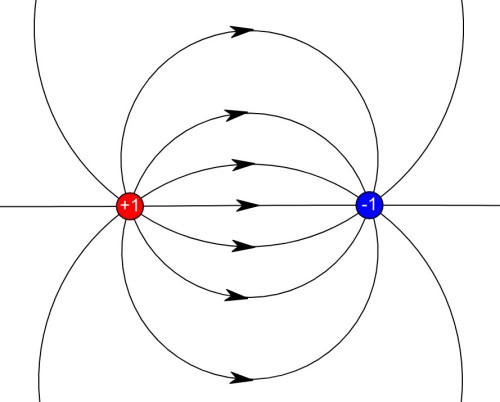Electric Charge
Electric charge is a fundamental property of matter that causes it to experience a force within an electromagnetic field.

The idea behind all of electricity is:
Fundamental particles can have 0, +1 or −1 electric charge:
- + and − are pulled towards each other
- + pushes + away
- − pushes − away
We sum it up by saying:
opposites attract and like charges repel
Electric charge is matter experiencing force in an electromagnetic field.
Electric charge can be felt far away (called an electric field).
In fact there is no limit, but it does get weaker the further we go.
Charge is measured in Coulombs (C) and can be any multiple of the elementary charge (e), such as 0, +1e, -1e, +2e, and so on.
- e = 1.602176634 × 10-19 Coulombs. So small!
- A Coulomb equals the charge of about 6.241509×1018 electrons. That is a lot!
Electrons have a charge of −1e and protons have a charge of +1e
Electric charge is conserved: it is neither created nor destroyed but can be transferred from one object to another.
Materials like copper and aluminum can easily have electrons knocked off atoms: we say they are "conductive":
Our atom loses an electron and is now positively charged
and the negatively charged electron is now mobile
A wire has this happening randomly all the time:
When a voltage is applied across a wire, something interesting happens! Extra charges get pushed in at the end:
The excess charge creates a net force that pushes free electrons along the wire, which in turn push other free electrons, causing a chain of electron movement.
After a short while it settles down to a net movement of charge in one direction (but still a bit random):
This flowing charge is called current.
Current is measured in Amps (or Amperes), and is equal to 1 Coulomb of charge flowing past in 1 second:
A Coulomb is equal to the charge of about 6.241509×1018 electrons
The symbol for Coulombs is C, and the symbol for Amps is A.
Some interesting things:
- It is the charge that pushes the electrons around
- The charge extends beyond the wire!
- But the only electrons free to move are in the wire so that is where the current flows
A flow of electricity is called current because it is similar to a current of water:

Also similar are: Coulombs → liters of water, and Amps → liters per second of water flow. See Electricity Water Analogy for more.
Coulomb's law
Charge causes Force.
But how much force is there between two electrons? Not much really, and it depends on the distance between them
It is all given by Coulomb's law:
F = k q1q2r2
- F = Force between particles in Newtons (N)
- k = Coulombs' Constant (8.9875517873681764 x 109 Nm2/C2, or more simply 9 x 109)
- q1 and q2 = the charge of each particle in Coulombs (C)
- r = distance (m)
The bigger either one of the charges the more force there is, but the force decreases by the square of the distance.
Example: Two electrons 1 mm Apart
The charge of a single electron is only about −1.6 x 10-19 Coulombs, let's use that for both q1 and q2 in Coulomb's Law:
Wow, that is small.
But there are a LOT of electrons in a piece of wire. A typical one meter wire has nearly 1023 atoms, most with a mobile electron.
Electric Fields
There is a lot more to learn about electric fields, see Electric Chirps andElectric Field Animation for more

electric field diagram
And there are equations to know! See Electric Charge Calculations
Fun Fact: Direction and Rate of Charge Flow
In a typical circuit, the flow of charge is from the positive terminal of the power source (such as a battery) towards the negative terminal. But actually it is the negatively charged electrons that move in the opposite direction, from the negative terminal towards the positive terminal.